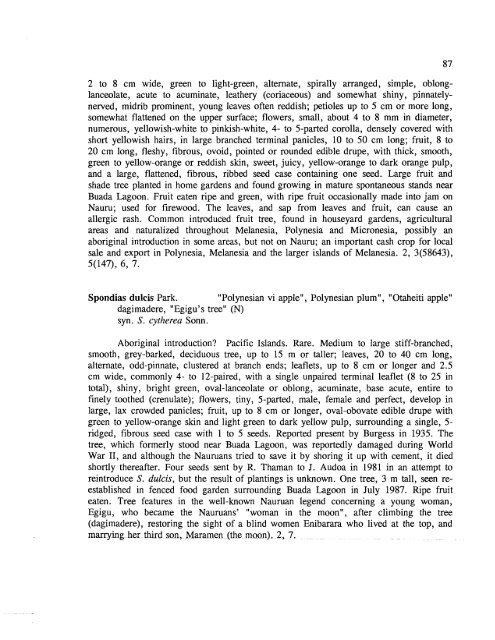atoll research bulletin no. 392 the flora of - Smithsonian Institution ...
atoll research bulletin no. 392 the flora of - Smithsonian Institution ...
atoll research bulletin no. 392 the flora of - Smithsonian Institution ...
You also want an ePaper? Increase the reach of your titles
YUMPU automatically turns print PDFs into web optimized ePapers that Google loves.
2 to 8 cm wide, green to light-green, alternate, spirally arranged, simple, oblong-<br />
lanceolate, acute to acuminate, lea<strong>the</strong>ry (coriaceous) and somewhat shiny, pinnately-<br />
nerved, midrib prominent, young leaves <strong>of</strong>ten reddish; petioles up to 5 cm or more long,<br />
somewhat flattened on <strong>the</strong> upper surface; flowers, small, about 4 to 8 mm in diameter,<br />
numerous, yellowish-white to pinkish-white, 4- to 5-parted corolla, densely covered with<br />
short yellowish hairs, in large branched terminal panicles, 10 to 50 cm long; fruit, 8 to<br />
20 cm long, fleshy, fibrous, ovoid, pointed or rounded edible drupe, with thick, smooth,<br />
green to yellow-orange or reddish skin, sweet, juicy, yellow-orange to dark orange pulp,<br />
and a large, flattened, fibrous, ribbed seed case containing one seed. Large fruit and<br />
shade tree planted in home gardens and found growing in mature spontaneous stands near<br />
Buada Lagoon. Fruit eaten ripe and green, with ripe fruit occasionally made into jam on<br />
Nauru; used for firewood. The leaves, and sap from leaves and fruit, can cause an<br />
allergic rash. Common introduckd fruit tree, found in houseyard gardens, agricultural<br />
areas and naturalized throughout Melanesia, Polynesia and Micronesia, possibly an<br />
aboriginal introduction in some areas, but <strong>no</strong>t on Nauru; an important cash crop for local<br />
sale and export in Polynesia, Melanesia and <strong>the</strong> larger islands <strong>of</strong> Melanesia. 2, 3(58643),<br />
5(147), 6, 7.<br />
Spondias dulcis Park. "Polynesian vi apple", Polynesian plum", "Otaheiti apple"<br />
dagimadere, "Egigu's tree" (N)<br />
syn. S. cy<strong>the</strong>rea: Sonn.<br />
Aboriginal introduction? Pacific Islands. Rare. Medium to large stiff-branched,<br />
smooth, grey-barked, deciduous tree, up to 15 m or taller; leaves, 20 to 40 cm long,<br />
alternate, odd-pinnate, clustered at branch ends; leaflets, up to 8 cm or longer and 2.5<br />
cm wide, commonly 4- to 12-paired, with a single unpaired terminal leaflet (8 to 25 in<br />
total), shiny, bright green, oval-lanceolate or oblong, acuminate, base acute, entire to<br />
finely too<strong>the</strong>d (crenulate); flowers, tiny, 5-parted, male, female and perfect, develop in<br />
large, lax crowded panicles; fruit, up to 8 cm or longer, oval-obovate edible drupe with<br />
green to yellow-orange skin and light green to dark yellow pulp, surrounding a single, 5-<br />
ridged, fibrous seed case with 1 to 5 seeds. Reported present by Burgess in 1935. The<br />
tree, which formerly stood near Buada Lagoon, was reportedly damaged during World<br />
War 11, and although <strong>the</strong> Nauruans tried to save it by shoring it up with cement, it died<br />
shortly <strong>the</strong>reafter. Four seeds sent by R. Thaman to J. Audoa in 1981 in an attempt to<br />
reintroduce S. dulcis, but <strong>the</strong> result <strong>of</strong> plantings is unk<strong>no</strong>wn. One tree, 3 m tall, seen re-<br />
established in fenced food garden surrounding Buada Lagoon in July 1987. Ripe fruit<br />
eaten. Tree features in <strong>the</strong> well-k<strong>no</strong>wn Nauruan legend concerning a young woman,<br />
Egigu, who became <strong>the</strong> Nauruans' "woman in <strong>the</strong> moon", after climbing <strong>the</strong> tree<br />
(dagimadere), restoring <strong>the</strong> sight <strong>of</strong> a blind women Enibarara who lived at <strong>the</strong> top, and<br />
marrying her third son,Maramen (<strong>the</strong> moon). 2, 7.

















